The Symbolism of the Baobab Tree in Sandplay Therapy
14 June 2014
By Dr Celia van Wyk
THE BAOBAB
Nunya adidoe, asi metu ne o
Knowledge is a baobab tree. No one person can embrace it all alone.
(An Ewe proverb from South-Eastern Ghana, West Africa, BEA Akoto-Abutiate, 2014, p. 5).
I pointed out to the little prince that baobabs were not little bushes, but, on the contrary, trees as big as castles; and that even if he took a whole herd of elephants away with him, the herd would not eat up one single baobab.
The idea of the herd of elephants made the little prince laugh.
“We would have to put them one on top of the other,” he said.
But he made a wise comment:
“Before they grow so big, the baobabs start out by being little.” (De Saint-Exupéry,
1972/2000, p. 15).
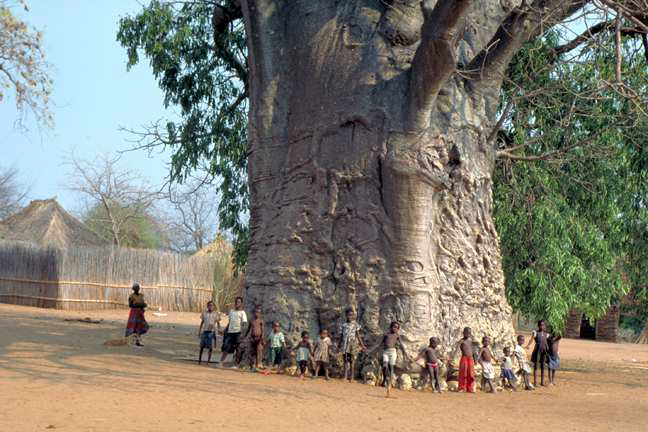
Adansonia Digitata: The baobab. (Fairchild, 1998), photo credit.
My husband Pieter, one of four brothers, as a child lived in Mussina (known as Messina in the post-apartheid era in South Africa). Mussina is a town on the southern side of the Limpopo River, on the border of South Africa and Zimbabwe, and is known as a baobab-rich area. Pieter told me that part of
their family time spent together, was to drive through the veldt down a dirt-road to visit the biggest and most popular of these trees. He said to me: “You know, Darling, it was like an exquisite artwork – trees are artworks, more so the baobab!”
He also told me that some of the trees were hollowed-out on the inside and a wonderful place for children to creep into and to play in there. To get access to the hole in a tree they many times had to climb over the thick roots visible above the ground. To get hold of some of the fruit pods, was a great challenge for the four brothers. When they got some, these pods were cracked open to get to the seeds, which they sucked on as the final reward to end a very special day.
In the 1980’s Pieter then, as a young married man to me, had to attend a military exercise camp near Mussina. He brought home some baobab fruits and for the first time, at the age of 23, I could taste this dainty delicatessen. It felt like a gift of love I received from my husband. Since then the baobab has held a very special place in my heart. As we shall see in my research, this love and respect for the baobab runs deep in the cultures of the people of South Africa.
The baobab (pronounced bey-oh-bab) tree has the scientific name of Adansonia Digitata (named after the naturalist Michel Adanson who first saw it around the middle 1700’s in Senegal, Dakar on the Western side of Africa (Elico, 2000, para. 1). In general terms this magnificent tree has many names of which baobab is the most well-known. According to Triebel (n.d.) the baobab has its origin from the Arab word “Bu hibab” meaning “fruit with many seeds” (para. 5). Other names include crème of tarter “kremetart”), tree of life (due to its long lifespan), chemist tree (due to its medicinal properties),
inverted or upside down tree (due to its branches looking like roots as if the tree was planted upside down) and monkey bread tree (due to its fruit that serves as a real delicacy for monkeys). Siyabona Africa (n.d.) mentions some more names on their website including boab, boaboa and tibaldi (section Name, para. 1).
One needs to search far and wide to find a tree with such rich value and symbolism as the baobab. This tree is found all over Africa in hot, tropical, frost-free or dry, desert areas. Related species are found in Australia (where it is also called the bottle tree due to its bottle shaped trunk there) and on
the island of Madagascar (where it has tall and thinner trunks than the African species).
As an African treasure, and amongst the people of Africa and South Africa, the baobab carries rich energy and wonderful stories. In Leydsdorp, a small mining town in South Africa, a hollowed-out baobab that could carry about 12 men at a time, once served as a bar for gold-diggers to quench their
thirst (Bulpin, 1980, p.268)
In the Kruger National Park of South Africa the two largest trees found are baobabs, both believed to be more than 2000 years old, and both popular tourist attractions. Siyabona Africa Group (n.d.) reported that the two trees, because of these unique features, were declared as amongst the first
“Champion trees” of South Africa by the Department of Water Affairs and Forestry (para. 1).
When one visits the beautiful Kruger Park, a trip to one of these two magnificent giants is normally on the itinerary! The picture below was taken in October 2012 during one of our visits to the Park.
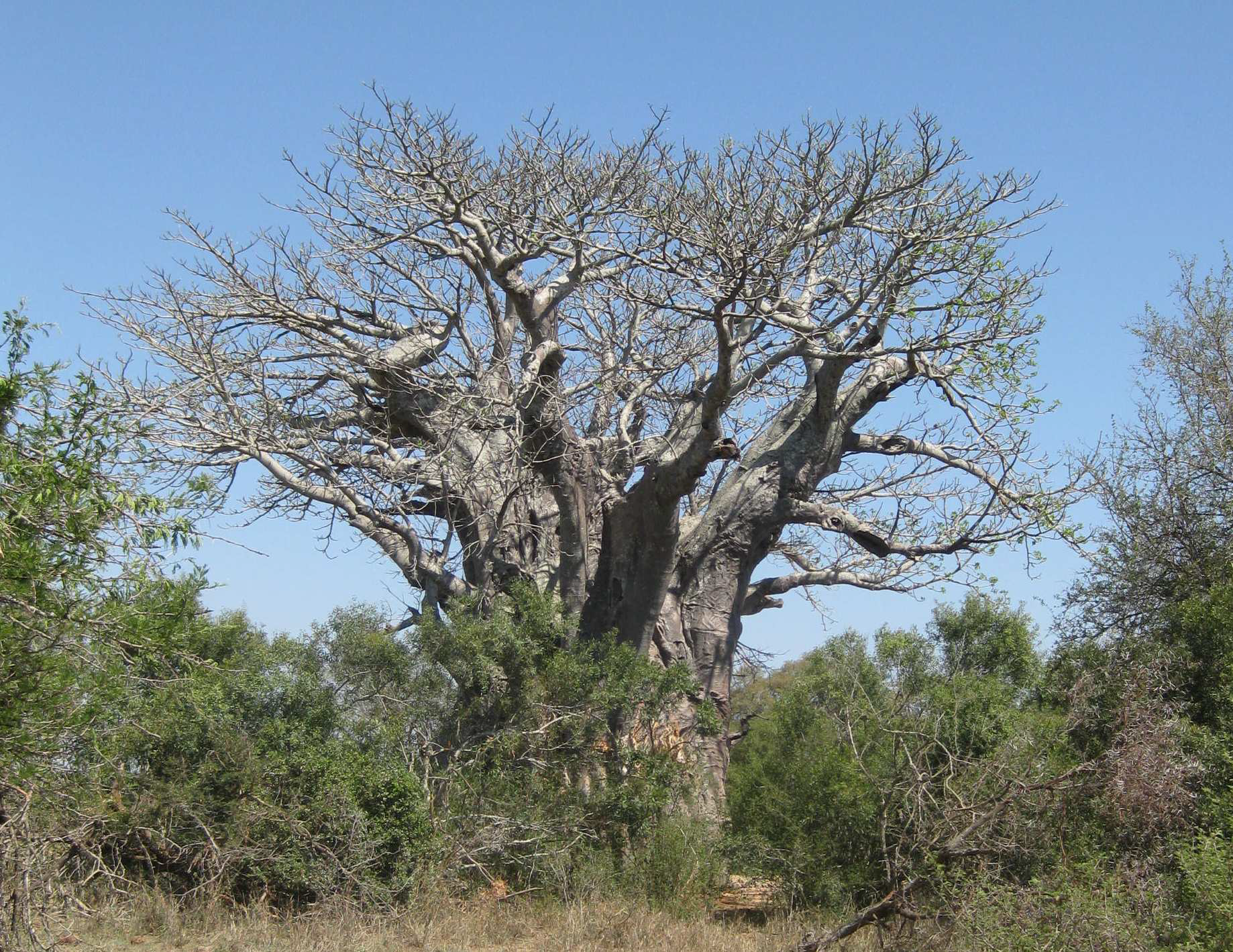
Baobab in Kruger Park, South Africa, October 2012
Because the trunk can be hollowed out, some baobabs have been made into a shop, bar, house, storage place, night club, prison, bus shelter and even a toilet. The Siyabona Africa Group (n.d.) also mentions another very old baobab in Zimbabwe that can keep up to 40 people in its hollow trunk
(section Description, para. 2).
There is a 400 year old baobab in the town square of Weida which is in Benin, a city in the southern parts of Nigeria. Weida is where Voodoo comes from and people worship pythons. An interesting fact about this baobab is that it is situated between the Voodoo temple and the Catholic Church, which are opposite each other. The Catholics believe that their people need to be reminded of God as they’re leaving the temple. A fellow sandplay practitioner told me that during her travelling there she spoke to some of the people at the town square who told her they (the people of Weida) worship both … (God and pythons). Here we find beautiful symbolism portraying the tension of opposites between pythons, human beings (the tree) and the church; thus between the underworld, the world and the heavenly world.
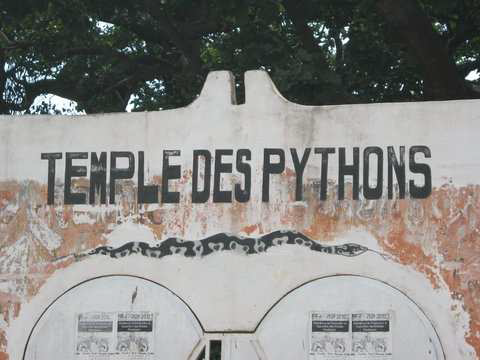
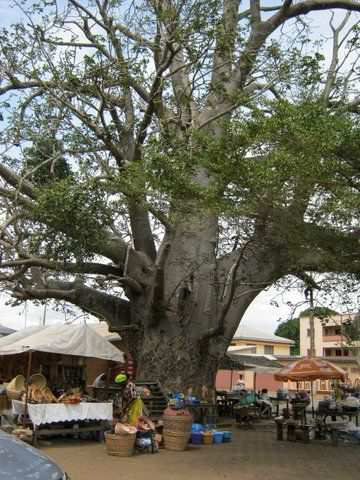
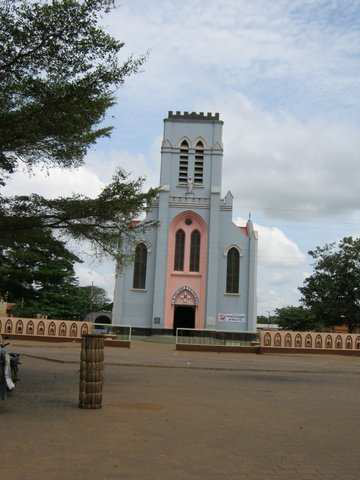
Photo 1: Temple of Pythons; Photo 2: Baobab tree in Weida; Photo 3: Catholic Church
Photos taken and supplied by fellow sandplay practitioner, Bev Wilson, (2014)
In Tanzania a young Muslim man named Musa one day towed the broken-down vehicle of Reverend George Healy to the town Bariadi, when they started to talk about religion and the tension between Christians and Muslims in Tanzania. That is when Musa said to the Reverend: “There is only
one God. God is like a large baobab tree with different branches that represent the different religions of Islam, Christianity, African religion and so forth. These branches are part of the same family of God – so we should work together” (Healy, 1998-2014, para. 3).
Indeed the baobab is represented widely in different religions, where it is mostly referred to as the tree of life. I will here mention only a few.
The Christian Bible has references to the tree of life as well as the baobab. According to Linsley (2011) the baobab was one of the trees found to have grown in the region of Abraham’s people. In her article she mentioned that “The baobab tree is likely the origin of the idea of waters flowing from the
tree” (para. 2) as described in Revelation 22:1-2:
“Then the angel showed me the river of the water of life, as clear as crystal, flowing from the throne of God and of the Lamb down the middle of the great street of the city. On each side of the river stood the tree of life, bearing twelve crops of fruit, yielding its fruit every month. And the leaves of the
tree are for the healing of the nations.”
Lindsey continued by explaining the symbolism of the tree of life beautifully in the article, as follows:
The “tree of life” in the Garden of Eden is a symbol of communion with God at the metaphysical sacred center. The Church Fathers regarded this tree as representing the cross upon which the Son of God died. In fact, the cross is four times spoken of as a ‘tree’ (Acts 5:30; 10:29; 1 Peter 2:24). Deuteronomy 21:23 says that “anyone who is hung on a pole [or tree] is under God’s curse.” Quoting this verse, the Apostle Paul explains that Christ bore that curse, “becoming a curse for us” (Galatians 3:13). The tree of life archetype is as old as the serpent archetype and the two are often shown together. The point of origin of both archetypes appears to be the Nile, the region from which Abraham’s ancestors came. The Church Fathers view the tree of life as a symbol of Jesus Christ and the serpent is the symbol of His adversary. We meet both in Genesis and in Revelation, at the beginning and at the end of the biblical story (The Tree of Life section, para. 1-3).
In the Jewish Torah it is written that after God drove man out of the Garden of Eden, He sent cherubim angels to guard the tree of life from people who had fallen into sin. He positioned them on the east side, with a “flaming sword flashing back and forth to guard the way to the tree of life” (Genesis 3:24). Jews believe that the tree of life is still guarded, but in the spiritual realm, by archangel Metatron (Hopler, n.d, para. 2).
The Jewish orphic tradition of Kabbalah features two types of trees of life; the upright tree and the upside down tree, of which the latter, called the original tree of life, symbolises life emanating from God’s world, the “divine world of unity” and its roots “flowing from the divine place of unity and infinite light”, thus God. It is described that the branches and the trunk infiltrate the existence of body, mind and soul by reaching down to man (us). It is called the “Tree of Emanation”, as it “flows downward from the source” (Wagner & Larkin, 2013, section Tree of life and Kabbalah, para. 2).
In Buddhism the tree of life is depicted as a Bodhi tree, not a baobab, however the archetypal symbolism of Buddha underneath the Bodhi tree resonates with the image of Christ on the cross as symbol of the world Saviour on the tree of life (Wagner & Larkin, 2013, section Tree of life and Buddhism, para. 1). This symbolises suffering and victory, sacrifice and salvation, death and rebirth.
The baobab looks like a tree that was pulled from the ground, turned upside down and planted again. It may be one of the first trees that appeared on earth and is known to become about 3000 years old according to carbon dating. Baobabs may reach a height of about 20m and the trunk may have a
circumference of 10m or even more. The tree carries leaves, flowers for only a short period in spring, fruit and seeds, and is without leaves for about 9 months of the year. In a description of the baobab without its leaves it is compared to a petrified octopus with tentacles raking towards the sky (Bulpin, 1980, p. 245).
Almost every part of the tree is useful, which makes it a product of nature utilised extensively for the best benefit of man and animal. The thick trunk is smooth and pinkish-grey in colour and the bark has a spongy texture that also protects the tree in case of fire.
The trunk serves as a reservoir for water during the dry season and can store up to 30,000 gallons of water. Local people would use a sharp object to drill a hole in the trunk, push a stopper in the hole, and get water as and when they need it by sucking through a grass straw or something similar.
Animals like baboons pull off the bark and suck from the spongy part by pushing a stick or something sharp in it to get to the water. Due to this feature the baobab is also called the “tree of life”, according to B4tea (2009-2014, para. 3).
The baobab’s juicy bark has wonderful properties. Animals suck on it after ripping it off and rural folks use the fibre the bark contains to make ropes, musical instruments, nets, hats and cloth. For this the bark is also first removed and the fibre stripped off. Amazingly the baobab regenerates the loss by producing new bark again.
The tree has exquisite large whitish blossoms which carries a strong aroma. According to Dohse (n.d.) bats pollinate the flowers by night causing it to develop into “velvety green fruits” (para. 2). The hanging fruit has a frank and acidic taste and monkeys and baboons like it very much. Inside the fruit we find seeds covered with a white talcum powder called pulp. The seeds are eaten or sucked on or mixed with the grain millet and then consumed. It can also be soaked in water to produce a refreshing lemony drink. Furthermore the seeds are traded for the production of pressed oil or made into a paste. The young leaves are used in salads or eaten like asparagus. The weblog B4tea (2009-2014) stated in a featured article about the healing powers of the baobab that there is a belief amongst some indigenes that if they drink the water in which the seeds get soaked, it would protect them from crocodiles! (para. 5).
Baobabs have numerous health and anti-oxidant benefits and can indeed be seen as a complete food source. According to Ohi (2012), the highly respected nutritional value of the tree comes to light when one realises the different parts to be a good source of energy, fat, protein, substantial quantities of calcium, potassium, magnesium, high levels of Vitamin A, C, D, E and F, sterols, niacin, and riboflavin, amino acids, glucose and fructose (section Nutritional components of baobab tree).
The cosmetic, health and medicine industries benefit widely from the baobab tree as well. The leaves are boiled in water and taken in small sips to lower fevers, cure asthma, coughs and lung related problems and some even believe it can cure malaria. Stomach problems are relieved by taking in some of the tartar powder and one is energised by chewing on the leaves. The baking agent “cream of tartar” comes from the citric and tartaric acids present in the pulp of the fruit. Ribeiro salutes the majestic qualities of the baobab in a beautiful song (2007). [Video file]. An amazing tree indeed!
The baobab tree is also important to South Africans in other ways; one of them is known as “The Order of the Baobab”. The Order of the Baobab is according to SAHO (n.d.), awarded to “South African citizens for distinguished service to our country. The service awarded is well above and beyond the ordinary call of duty.” Journalist Ryland Fisher reported in the Daily Maverick of 29 April 2013 about Mrs. Nontsikelelo Qwelane, the oldest teacher in South Africa at the age of 92 years, who received this reward for her community contribution to our country. She still teaches geography to final year school students at a private college (Fisher, 2013, para. 1-7). Only the Order of Mapungubwe (which was awarded to Mr. Nelson Mandela in 2002) is a higher national Order than the Order of the Baobab.
There are many stories and myths containing baobabs. One of the legends, in different versions, tells how the devil, God or the gods for different reasons got angry and pulled the baobab from the earth by its roots, and planted it upside down to punish, or silence or to keep it from moving around (Wickens, 2008, p. 50). The symbolism here may point towards shadow aspects to be aware of in even the most balanced, fulfilling aspects of one’s life.
In African Folklore we find the delightful legend of “The three tests” from a Swahili African tribe of East Africa (Duane, 2004) about a young man’s travels to find his six imprisoned brothers in a sultan’s country. Three good deeds along his journey gained him valuable friends whom would help him later on to master some important tasks. Once in the sultan’s country, through his acts of bravery he could free his brothers, and he also met a beautiful young lady whom he fell in love with. To gain her father, the sultan’s permission for the young man to wed her, he had to succeed with 3 tests. One of it was to cut through a baobab’s trunk with one stroke of his sword. His friends the jinns (invisible spirits) brought him an army of white ants that gnawed at the trunk, leaving only the bark, which helped the young man to complete the task successfully (p. 112-119). This is a beautiful example of the journey from West to East, in the psyche thus the awakening and transformation of consciousness, from ego to spirituality, from ego to Self, also by making use of his inner spiritual strengths, the jinns. “The West had mapped the material world, but the East had mapped the interior world” (Crowley, 1999, p. 119). Interestingly is the strong number symbolism of the total of 7 brothers of whom 6 needed to be set free, 3 good deeds
and 3 tasks to complete. Robertson (1987) cited Jung (CW8:870) as describing number symbolism “psychologically as an archetype of order which has become conscious” (para. 2). In this story we experience the process of ordering from unconscious to conscious happening through the journey of the
young man.
Another sweet African baobab story “The secret heart of the tree”, as told by Davies (2009), is about a well-mannered but tired hare who asked a baobab tree politely if he could rest a bit in its shade. The hare could quench his thirst from a fruit that fell from the tree, scratch his back against the
baobab’s bark, every time being very grateful. Because of his good manners he could enter the tree, which was filled with jewels, lots of lovely fruit and a beautiful golden light. The tree then offered him a choice of something to take, and he chose a small golden ring for his wife. Mrs. Hyena saw the ring and kept on nagging the hare for the truth where she got it from, and ordered her husband to also go to the tree. As a greedy animal, with bad manners, hyena stuffed himself with the tree’s treasures. Just as he wanted to leave, the tree closed down on him, and as far as we all know, hyena is still trapped inside the tree (p. 2-4). Here we experience inflation causing disintegration of the non-stable or under-developed ego, thus the Self, absorbed by the ego, and goodness absorbed by its opposite, evil.
When one thinks of a baobab tree, the well-known “The Little Prince” story comes to mind. This story features 3 baobabs on the little prince’s planet, contaminated with bad seeds. He warned that if a baobab is not attended to by getting rid of these seeds, the badness will spread through the roots,
overtaking its whole planet. The effect would be the planet splitting in pieces, thus being destroyed. The little prince compared the care of a baobab with one’s own cleaning system, getting rid of toxins by attending the bathroom regularly. This symbolism of the baobab is showing towards the importance of addressing the shadow and the darker side in a timely manner, or else it may poison one’s whole body.
If one does not take care of your baobab, it can take over your life and you can never abolish it. (If “you attend to a baobab too late, you can never get rid of it again”, p.8).
Another well-known Disney story containing a baobab, is the monkey Rafiki’s tree in the Lion King. Rafiki, meaning friend, an old but very wise creature, lived in a baobab tree. He acted as the lion Mufasa, king of Pride Land’s, advisor and spiritual guide by letting him know when Mufasa’s awful
brother Scar planned evil deeds against him. When Mufasa’s son Simba was born, Rafiki was a guest of honour who bestowed blessings on the little prince. Since then he kept an eye on Simba’s life journey guiding him through mystical signs he read in paintings he made on the side of his baobab tree. Tieman (1995) described Rafiki as a “tribal medicine man or an ancient shaman” (section Rafiki, Character), who knew what he knew, and taught his wisdom to those around him. His centre was his baobab tree, from where he had an overview of Pride Rock, the outlook post of the king and his son.
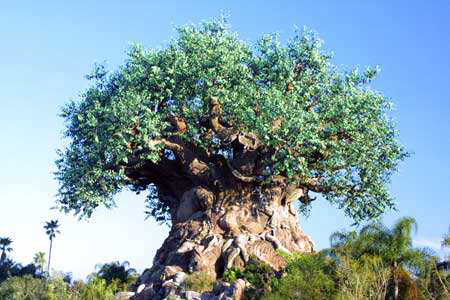
Disney World illusionary artificial baobab tree, constructed by various artists from all over the world (Zanolla, 1997-2014), photo credit.
Gauding (2009) stated that the Tree of Life in all cultures carries the symbolism of fertility. She also said that the Tree of Life in Babylonia grew in the centre of paradise, and was known as a magical tree (p. 37). O’Connell, Airey & Craze (2007) described the symbolism of the inverted tree as originated
from the Jewish Kabbalah and the Hindu Bhagavad-Gita, where the upside-down tree presents God in heaven as the beginning of all things. These authors also associated the tree image with the human nervous system, emphasising the connection between the human micro- and macrocosm (p.183).
Describing the tree of life they stated it as a “Universal symbol of creation, the tree of life has its roots in the waters of the underworld, its trunk in the earthly world, and its branches in the heavens. “ …seen as a way of accessing other worlds” (p. 501). This is a beautiful description of the integration to be between conscious and the unconscious dimensions.
Eliade and Jung both put attention to the fact that the tree and the snake are illustrations of each other. Hannah (2006) referred to the “hidden chaos in creation” and quoted Jung as follows:
The serpent in Genesis is an illustration of the personified tree-numen; hence it is traditionally presented in or coiled round the tree. It is the tree’s voice, which persuades Eve – in Luther’s version – that “it would be good to eat of the tree, and pleasant to behold that it is a lusty tree.”
In the fairy tale of The Spirit in the Bottle, Mercurius can likewise be interpreted as a tree-numen….. The tree stands for the development and phases of the transformation process, and its fruits or flowers signify the consummation of the work. In the fairytale Mercurius is hidden in the roots of a great oak tree, i.e. in the earth. For it is in the interior of the earth that the Mercurial serpent dwells (Jung, 1969, para. 372), (p. 254).
The baobab fits the above descriptions well, as it is also a tree with long outstretched roots in the earth. Hansen (n.d.) stated in her article: “The baobab’s almost eerie tangle of branches gives shelter to many of the players in the ecosystem— ….. snakes, ….. who may live their entire life in a single tree” (para. 9).
According to Cirlot (1971/2002) the inverted tree with its roots in the air represents the same cosmic energy as the mountain that becomes wider seen from above, representing “multiplicity, the universe in expansion, involution and materialisation”. Both had their location at the “centre” of the world, where the vertical axis formed by their presence, crosses with the world/horizontal axis, represented by earth. He further compares it anatomically with the spinal column in the human body (p. 219). The metaphor “grow a spine” means to become strong and develop courage. Using a tree and
especially a baobab in a sand tray may indicate this development in the client’s psyche. Interestingly Taschen (2010) mentioned that the older heartwood of a tree is known as its spine, like the backbone in the human body (p. 336).
The baobab is the archetypal symbol of the inverted tree, where we integrate and bring the heaven into the earth and the earth into the heaven. It also represents the link between the three worlds of heaven, earth and the underworld, thus the alignment of the conscious position with the Self.
The baobab therefore may be a representation of the Self in a person’s sandplay process. According to Jung in von Franz’s work (1974/1995) the tree symbolises the inner process of a person towards consciousness, regardless of the ego’s roll; the “urge towards individuation … independent of
consciousness” (p. 43). Tresidder (2006) described trees as “… the supreme natural symbols of dynamic growth, seasonal death and regeneration” (p. 76).
Trees are used in many myths, fairy tales, fables and stories, many as growing on hallowed mountains, in sacred gardens or in spiritual waters, solidly rooted in the unseen (underworld / unconscious), going through earth (world / conscious), stretching towards heavens (spirit / God), “An almost universal symbol, the Tree of Life often becomes a metaphor for the whole of creation” (Feather, 2012, para. 2).
In my sandplay collection I have three baobab trees in different sizes made from wire, bought from an African fellow who bends the wire and transforms it into the most wonderful creations. I also have two baobabs made from banana leave fibre, which I bought at an African outdoor market. All of these trees are used regularly by my clients. Many times the trees are placed in the centre of a tray, or in a significant spot as part of the sand scene. The trees are used as is, or decorated with things like birds, flowers, ribbons and beads. Lots of times the wired trees are put in the sand with rocks or stones around the base of the trunk.
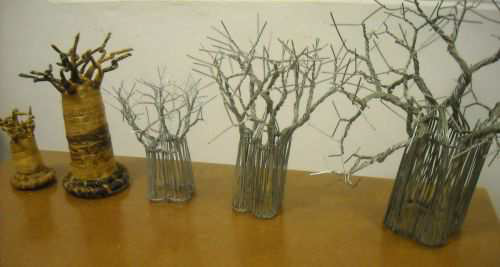
My sandplay baobab collection
I had one male client of 24 years old who in his 26-session sandplay process used baobabs in four of his trays. In three of these four trays the tree was put in the centre, a prominent and strong focus point. The young man came to the clinic concerned about his poor self-esteem and “to figure out who he is”.
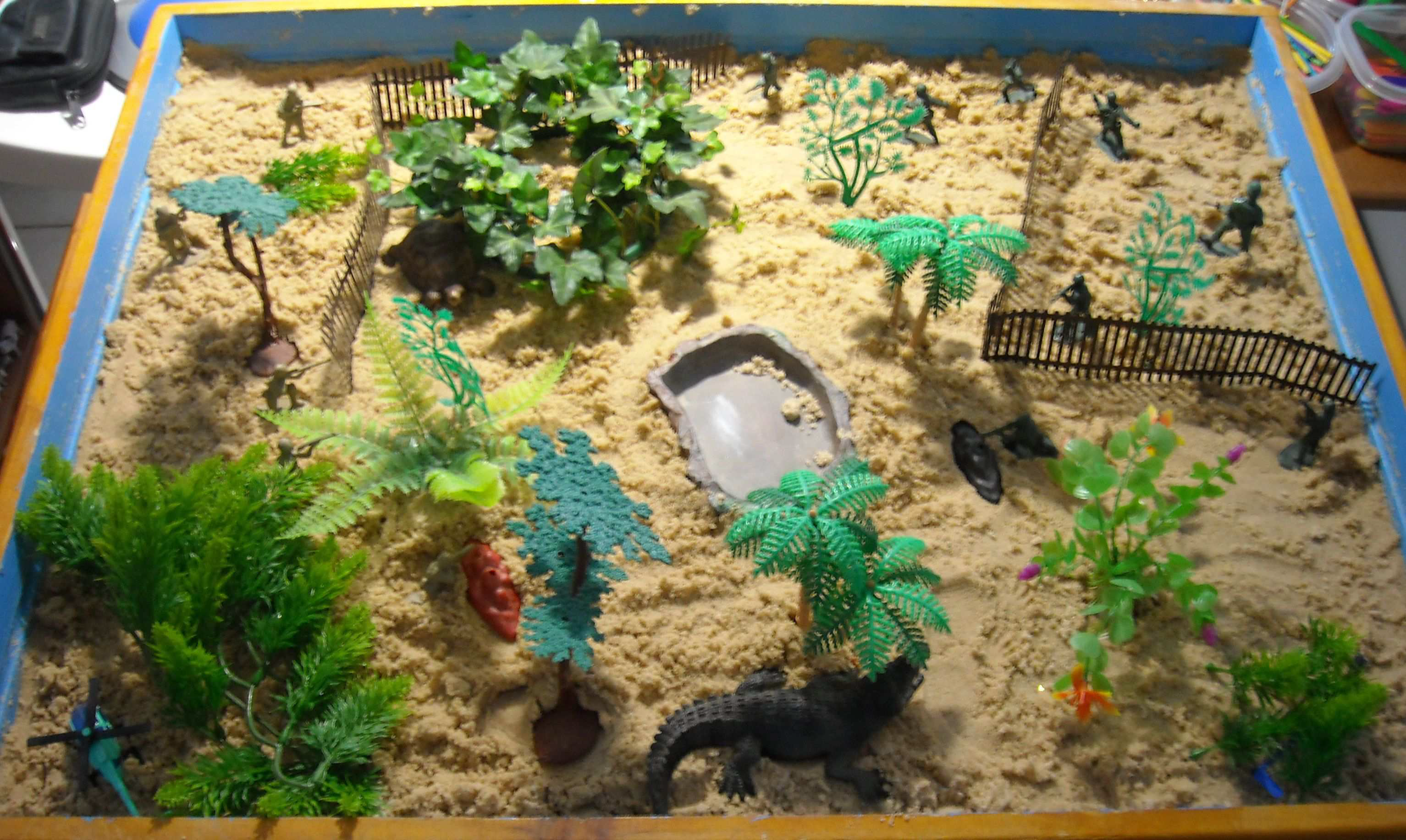
Tray 1:
In his first tray it became evident that there were a lot of issues around the mother archetype which needed to be addressed. This was seen in an empty pond which may represent a lack of nurturing experienced from his mother and a huge alligator which may represent the devouring aspect of the negative mother. The first tray also seemed as if carrying a very strong masculine energy as a psychic strength.
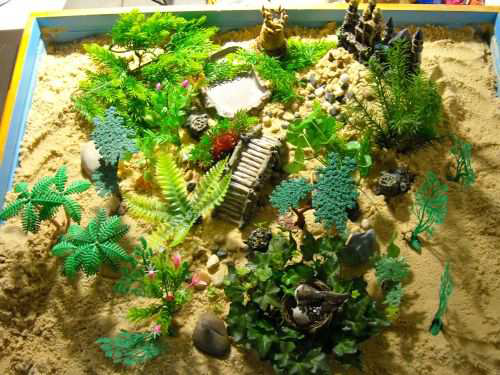
Tray 2:
The first time the baobab appeared in the client’s tray, was in session 2. It was put at the far centre side of the tray. In the tray the tree has a strong presence. The masculine feeling from tray one is felt in this tray too, but when one looks further and deeper, one realises that there is a feminine
component present here as well, cultivated in the birds in the nest, the flowers and also the empty dam / fish pond from tray 1. The baobab is placed opposite the nesting birds, with a bridge connecting these components. Although the tree has beautiful feminine symbolism portrayed in its widespread branches like a queen’s crown, and its roots strongly anchored in the earth, its solid vertical phallic trunk carries masculine energy, which brings forth a powerful holding of the opposites with the feminine nesting birds. We also experience holding of the opposites between the nesting birds and the ring of ivy.
Bradway and McCoard (2005) refer to this scenario as “bridging the opposites.” They further mention that it may be constituted by a real bridge (p. 86), like in my client’s scene. The ivy, (it also appeared in the first tray), is related to the Dionysian cults. According to Atsma (2000-2011), there is a beautiful
myth about the ivy described as follows: “After the birth of Dionysus his jealous stepmother Hera sought to destroy him. So his nurses, the Nymphai Nysiades screened his crib with ivy-leaves to keep him safely hidden. Kisseis (the lady of the ivy) was the name of one of these nymphs” (Ivy section, para. 5). The nesting birds in my client’s tray almost feels like that crib surrounded by the ring of ivy. The baobab and castles on the other hand carry energy of solidity and endurance, and provide a feeling of the work on a deeper level, as castles may symbolise holding of deep secrets and work from the unconscious.
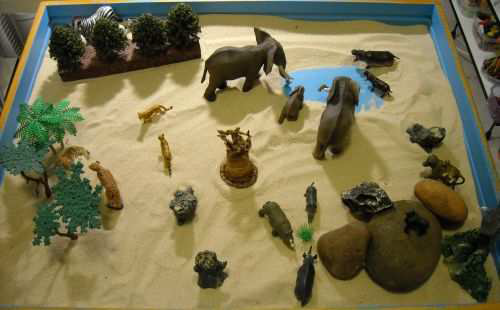
Tray 9:
In tray 8 (prior to this tray 9) the client reached a centering of the Self. In this tray (tray 9) he put the baobab in this centre of the Self, forming an ego self-axis. The tree thus serves as the vertical axis forming a connection between the earth and the heaven, and the sand serves as the horizontal axis
providing connection between the earth and the water. The work in the tray is on a more conscious level, which we can observe in the theme of animal-vegetative representation. The tray consists of numerous nurturing elements like the animals and their babies, and their grazing, feeding and drinking which is also portrayed here. We experience the mother-child unity in various representations here.Furthermore we see the availability, willingness and greater access to the unconscious for more and deeper work, and this is portrayed in the opening made for the elephants and hippopotamuses to drink water from.
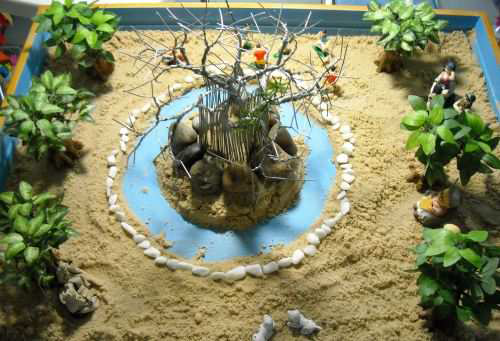
Tray 15:
In tray 15 the client again positioned the baobab tree in the middle of the tray, at the centre of the Self, forming another centering. This time he used the biggest baobab tree I had in my collection at that time, made out of wire. The tray looks like a mandala and the whole scene created provided a very special luminous feeling about it. Here we experience integration of masculine and feminine on a new level. This can be observed in the male and female figurines of different generations used together. The client is really accessing deeper spiritual layers in his tray. We experience it in the two old wise men from the East positioned in the near left corner of the tray, and also in the circle of white pebbles he carefully, attentively placed around the tree. We again experience the ego self-axis point with the baobab tree as forming the vertical axis, and the huge rocks around it forming the horizontal axis. What we feel here is the tree forming the means to access the deep unconscious in the surrounding waters, and the rocks providing the stability to do so.
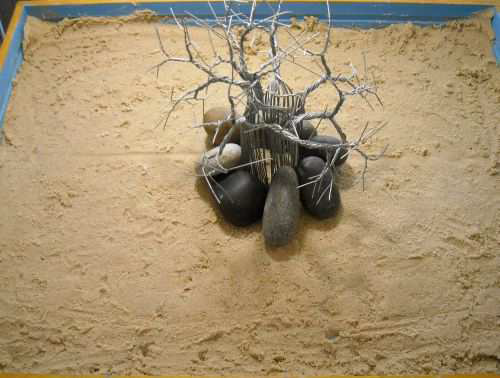
Tray 20:
Like in previous trays, another centering happened in tray 20, with all elements brought together to the middle of the tray. Eliade (1991) described the symbolism of the centre by means of the highest point of the cosmic mountain, and also the world tree, which the baobab is known as, as the “navel of the Earth, the point at which creation began”. He continued by explaining that when God created the world from this navel point, it started to spread out from there into different directions. He stated that the same symbolism happens in Ancient India in the Rig Veda “where the Universe is
conceived as expanding outward from a central point” (p. 43). This image compares well with the image of the baobab in the client’s tray as spreading its branches far and wide from a central point. The tree appears very solid in the tray. It almost feels like a fire! The eight rocks protect the tree, and the tree (client) feels safe. He feels more in charge, more himself, and his consciousness is starting to catch up with the deep work he has done so far. This tray provided a real energy moment in his life. Eliade (2005) described it beautifully when he referred to the centre as “pre-eminently the zone of the sacred, the zone of absolute reality” (p. 17).
It was not long after this tray that the client left therapy. Not only did he discover himself, he also met a lovely young lady who did not represent his mother at all, and whom he married a few years later!
This special process and connection of my client with the baobab had me ponder on the popularity of the tree in general life as well as in sandplay sessions of clients, and I came to the conclusion that the baobab has two powerful aspects that emphasize its popularity and uniqueness:
It is a tree that has the ability to heal itself from within, as well as heal man and animal on a physical level due to its strong medicinal properties. But also as symbol, maybe more astounding is the baobab’s ability to represent healing on a deep psychic level, encompassing all aspects of balance,
strength, personal power and maybe most importantly, self-healing and healing of the “Self”. No wonder it is referred to as “The Tree of Life, the World Tree”.
References
Atsma, A. J. (2000-2011). Theoi Greek mythology project. Exploring mythology and the Greek gods in classical literature and art. Retrieved from http://www.theoi.com/Flora1.html
B4tea Teatime Technews and More. (2009-2014). Baobab Tree Facts: Interesting Information about its Healing Power. [Web Log]. Retrieved from
http://b4tea.com/information/baobab-tree-facts-interesting-information-about-its-healing-powers/
BEA Akoto-Abutiate, D. (2014). African Theology/ies: A contemporary mosaical approach. United Kingdom: AuthorHouse
Bulpin, T. V. (1980). Reader’s Digest. Illustrated guide to Southern Africa. Cape Town, South Africa: The Reader’s Digest Association of South Africa (Pty). Ltd.
Bradway, K & McCoard, B. (2005). Sandplay – silent workshop of the psyche. East Sussex, UK: Routledge
Cirlot, J. E. (1971/2002). A dictionary of symbols. New York: The Philosophical Library, Inc.
Crowley, V. (1999). Jung a journey of transformation. Exploring his life and experiencing his ideas.
Illinois: Theosophical Publishing House.
Davies, A. (2009). The secret heart of the tree. An African legion. Retrieved from https://www.k-state.edu/assessment/resources/ethics/tree09.pdf
De Saint-Exupéry, A. (1972/2000). The little prince. Cape Town. South Africa: A. A. Balkama Doshe, C. (n.d.). Baobab superfruit. The baobab. Retrieved from http://baobabsuperfruit.com/the-tree/
Duane, O. B. (2004). African myths and legends. Great Britain: Brockhampton Press
Eliade, M. (1991). Images and symbols. Studies in religious symbolism. New Jersey: Princeton University Press
Eliade, M. (2005). The myth of the eternal return. New Jersey: Princeton University Press
Elico. (2000). The Baobab Tree. Retrieved from http://news.bbc.co.uk/dna/place-lancashire/plain/A295472
Fairchild, M. M. (1998). Photograph of baobab tree and children, Africa. Photo credit. Retrieved with permission from http://www.michaelfairchild.com/world_faces/images/Baobab-&-children.jpg
Feather. (2012). Spiritual inspiration. Trees. Retrieved from http://www.spiritualinspiration.org/t5889-trees
Fisher, R. (2013). National orders: a cause to celebrate. Retrieved from http://www.dailymaverick.co.za/opinionista/2013-04-29-national-orders-a-cause-to-celebrate/#.UqWkaTuVN94
Gauding, M. (2009). The signs and symbols bible. The definite guide to the world of symbols. Great Britain. Octopus Publishing Group, Ltd
Hannah, B. (2006). The archetypal symbolism of animals. Illinois, USA: Chiron Publications
Hansen, T. (n.d.). Senegal’s baobab (Adansonia Digitata) – beloved symbol. Retrieved from http://www.baobabcenter.org/senegals-baobab-adansonia-digitata%E2%80%94-beloved-symbol
Healy, J. G. (1998-2014). African proverbs, sayings and stories. God is like a large baobab tree. Retrieved from http://www.afriprov.org/index.php/african-stories-by-season/10-christian-values/55-god-is-likea-large-baobab-tree.html
Hopler, W. (n.d.). Baobab: The tree of life. Retrieved from http://angels.about.com/od/MedicalMiracles/p/Baobab-The-Tree-Of-Life.htm
Linsley, A. C. (2011). Just Genesis. Trees in Genesis. Retrieved from http://jandyongenesis.blogspot.com/2011/05/trees-in-genesis.html
O’Connell, M., Airey, R., & Craze, R. (2007). Symbols, signs & dream interpretation. Identification and analysis of the visual vocabulary and secret language that shape our thoughts and dreams and dictate our reactions to the world. London: Anness Publishing, Ltd
OHI. (2012, August 14). Baobab-powder.com. Baobab research and reviews. Retrieved from http://www.baobab-powder.com/En/Post/
Ribeiro, A. M. Uploaded (2007, February 25). Árvore africana ao som de uma marrabenta (African Tree at the sound of a marrabenta): Baobab. [Video file]. Retrieved from http://www.youtube.com/watch?v=HgT98VK6mZk&feature=youtu.be.
Robertson, R. (1987). Godel and Jung, psychological perspectives (Vol. 20. #1). Retrieved from https://www.academia.edu/217152/Evolution_of_Number_the_Archetype_of_Order
SAHO South Africa History Online Organisation. (n.d.). The order of the baobab. Retrieved from http://www.sahistory.org.za/order-baobab
Siyabona Africa (Pty) Ltd. (n.d.). The definitive Kruger Park Guide. Retrieved from http://www.krugerpark.co.za/africa_baobab.html
Siyabona Africa (Pty) Ltd. (n.d.). The definitive Kruger Park Guide. Retrieved from http://www.krugerpark.co.za/krugerpark-times-3-12-limpopo-trees-23099.html
Taschen, 2010. The book of symbols. The archive for research in archetypal symbolism. Reflections on archetypal images. Köln: Taschen GmbH
Tiemann, B. (1995). Walt Disney Pictures. The lion king world wide web archive. Retrieved from http://www.lionking.org/~s-tlk/old/characters
Tresidder, J. (2006). Symbols and their meanings. The illustrated guide to more than 1,000 symbols – their traditional and contemporary significance. London: Duncan Baird Publishers, Ltd
Triebel. (n.d.). The Baobab. Retrieved from http://baobab.org/en/
Von Franz, M.L. (1974/1995). Shadow and evil in fairy tales. Massachusetts: Shambhala Publications, Inc
Wagner, M. & Larkin, J. (2013). Tree of life teachings. Living with passion, heart and purpose. Retrieved from http://www.treeoflifeteachings.com/tree-of-life/
Wickens, G. E. (2008). The Baobabs: Pachycauls of Africa, Madagascar and Australia. New York: Springer Publishing
Zanolla, L. Senior Editor. (1994-2014). Walt Disney World Information. Disney’s Animal Kingdom – Tree of life. Retrieved from http://www.wdwinfo.com/wdwinfo/guides/animalkingdom/ak-discovery-tree.htm

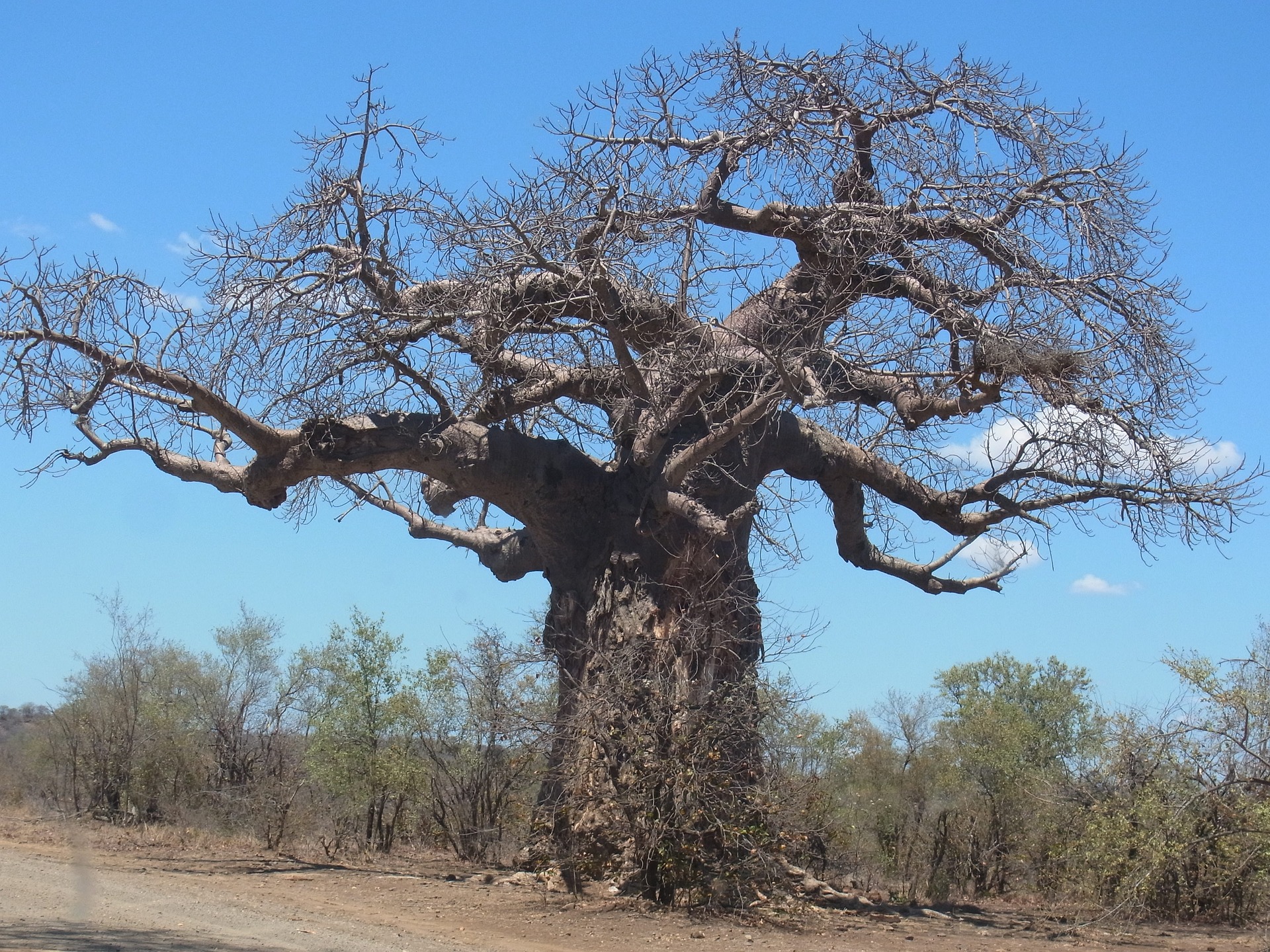

Comments are closed